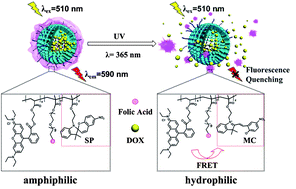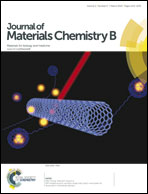Light-responsive amphiphilic copolymer coated nanoparticles as nanocarriers and real-time monitors for controlled drug release†
Abstract
Herein, light-responsive nanocarriers based on hollow mesoporous silica (HMS) nanoparticles modified with spiropyran-containing light-responsive copolymer (PRMS-FA) were fabricated via a simple self-assembly process. HMS modified with long-chain hydrocarbon octadecyltrimethoxysilane was an ideal base material owing to its good biocompatibility and drug capability. The spiropyran-containing amphiphilic copolymer could shift its hydrophilic–hydrophobic balance to become hydrophilic upon UV (λ = 365 nm) irradiation and then break away from the hydrophobic surface of the HMS core, followed by the uncaging and release of the pre-loaded anticancer drug. Simultaneously, the fluorescence resonance energy transfer (FRET) process based on the structural transformation of PRMS-FA was observed, which could act as a real-time monitor for the light-controlled drug release. Our model experiments in vitro tested and verified that this composite nanocarrier has good biocompatibility, active tumour targeting to the folate receptor over-expressed in tumour cells, is non-toxic to normal cells and that light-controlled drug release with real-time monitoring can be achieved.


 Please wait while we load your content...
Please wait while we load your content...